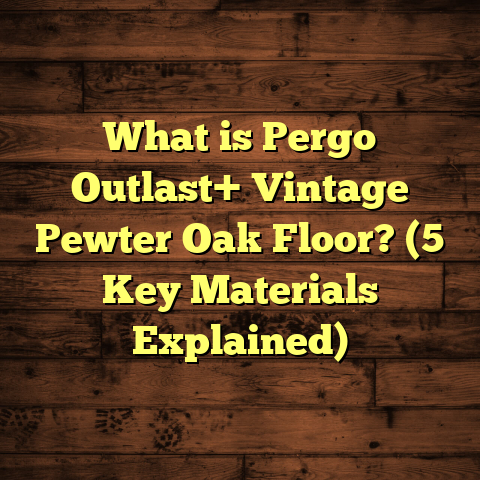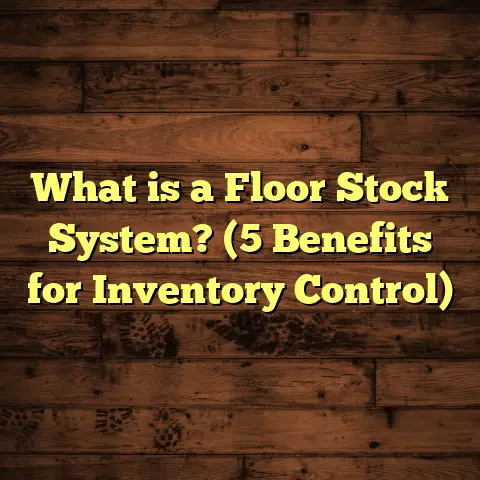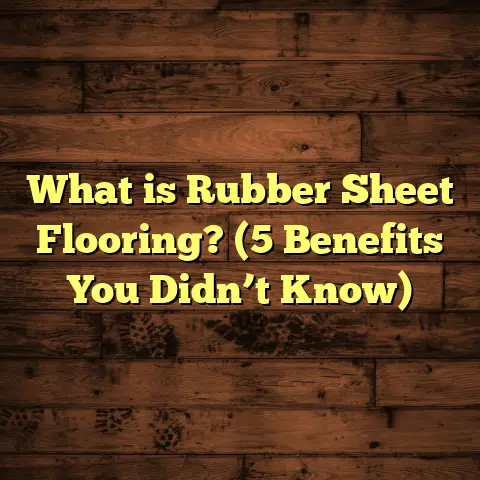What is HDF Locking Flooring? (5 Benefits for Smart Homeowners)
I have to admit, when I first started working with different flooring options, the idea of installing floors myself felt overwhelming. But then I discovered HDF locking flooring, and it changed the game. The ease of snapping boards together without glue or nails made the whole process much more approachable—even for someone like me who’s not a professional carpenter. If you’re curious about what this type of flooring is and why so many homeowners are choosing it, let me walk you through everything I’ve learned over the years.
What is HDF Locking Flooring?
When I first heard the term “HDF locking flooring,” I had no clue what it meant. So I decided to break it down for myself and anyone else who might be wondering: what exactly is this?
HDF stands for High-Density Fiberboard. It’s a type of engineered wood product created by compressing wood fibers with heat and pressure until they form a dense, solid board. This process results in a material that’s stronger and denser than the more commonly known MDF (Medium-Density Fiberboard).
What about the “locking” part? That refers to the way individual flooring planks connect. Instead of using nails, glue, or staples, these planks have specially designed edges—usually tongue-and-groove or click-lock profiles—that allow them to snap together tightly. This creates a floating floor system where the entire floor “floats” above the subfloor without being glued or nailed down.
Breaking Down the Components
- Core Material (HDF): The heart of the plank, providing strength and stability.
- Wear Layer: A clear protective layer on top that guards against scratches, stains, and wear.
- Decorative Layer: A high-resolution printed image that mimics natural wood grains or other patterns.
- Backing Layer: A moisture-resistant layer on the bottom that stabilizes the plank and prevents warping.
This combination offers a floor that’s visually appealing, durable, and easier to install compared to traditional hardwood.
Why HDF?
You might be wondering why manufacturers use HDF instead of solid wood or other materials. Here’s what I found interesting:
- Consistency: Because it’s engineered, HDF has fewer imperfections than natural wood.
- Dimensional Stability: It expands and contracts less with changes in humidity.
- Cost-Effectiveness: It’s cheaper to produce than solid hardwood.
- Environmental Impact: It often uses recycled wood fibers, making it more eco-friendly.
From my experience, these advantages translate into a more predictable product that performs well over time.
How I Came Across HDF Locking Flooring
Years ago, I was helping a friend remodel their home. They had a tight budget but wanted something that looked good and would last. We initially considered solid hardwood but quickly realized it was beyond budget and required professional installation.
That’s when we stumbled upon laminate flooring with an HDF core and locking system. Curious about how it worked, I watched several installation videos online and decided to try it myself on a small guest bedroom project.
The process was surprisingly straightforward. We didn’t need glue or nails; all we needed were some spacers, a tapping block, and a rubber mallet. I was impressed by how quickly we could lay down the floor without much mess or hassle.
That project opened my eyes to how HDF locking floors blend DIY-friendliness with quality results.
Five Benefits for Smart Homeowners
1. Easy Installation — No Special Tools or Experience Needed
I’ll be honest: flooring installation used to intimidate me. Solid wood floors required nails and specialized machinery. Tile installation involved messy grout and leveling challenges.
HDF locking flooring changed that perception completely. The click-lock design means you simply angle one plank into another and press down until they snap. No glue drying time. No nails to hammer.
I once installed a 200 sq ft living room floor in under six hours by myself, including cutting around door frames and corners. The only tools I used were:
- A rubber mallet
- Spacers to maintain expansion gaps
- A utility knife for trimming underlayments
- A saw to cut planks (a basic miter saw worked fine)
Because the boards lock tightly, there’s minimal chance of movement after installation. Also, if you make a mistake or need to replace a plank later, you can simply unlock and remove it without damaging surrounding boards.
I recommend beginners start in a smaller room first to get a feel for the system before tackling larger spaces.
2. Durability That Stands Up to Daily Life
Durability is key for me because my house gets a lot of foot traffic. Between kids running around, pets scratching occasionally, and furniture moving during cleaning days, flooring takes a beating.
HDF boards are dense enough to resist dents and impacts better than many laminates with MDF cores. The fiberboard core can handle more weight without cracking or breaking.
Here are some numbers I found in manufacturer specs:
- HDF density averages between 800-900 kg/m³ (kilograms per cubic meter), significantly higher than MDF (~600-700 kg/m³).
- Scratch resistance tests show some HDF floors withstand up to 10 Newtons force before visible damage.
- Wear layers on quality products range from 12 mils (0.3mm) to 20 mils (0.5mm), thicker layers correlate with longer-lasting finishes.
In my own home, I installed HDF locking floors in both the kitchen and hallway—two of the busiest spots—and after three years, they still look great without signs of wear.
3. An Affordable Flooring Option Without Sacrificing Style
Let’s talk money because that’s often the deciding factor for homeowners like us. Solid hardwood floors can cost between $8 and $15 per square foot just for materials—not including installation fees.
On the other hand, HDF locking floors usually fall between $2 and $5 per square foot depending on brand and design complexity.
I did a detailed cost comparison last year when redoing my home office:
| Type | Material Cost (per sq ft) | Installation Cost (per sq ft) | Total Cost (for 200 sq ft) |
|---|---|---|---|
| Solid Hardwood | $10 | $4 | $2,800 |
| HDF Locking Floor | $3 | $2 | $1,000 |
| Vinyl Plank | $4 | $2 | $1,200 |
You can see the savings add up quickly, especially if you decide to install it yourself.
To plan my budget accurately, I used FloorTally—an online calculator that factors in local labor rates and material prices. It helped me avoid ordering too little material by including waste percentages based on room shape and size.
This kind of tool is invaluable if you want realistic cost estimates without spending hours contacting suppliers or contractors for quotes.
4. Good Moisture Resistance When Paired with Proper Underlayment
One concern people often have about engineered wood products is water damage. While HDF itself isn’t fully waterproof, its high density makes it more resistant to moisture absorption compared to MDF or particleboard cores.
By combining HDF locking flooring with moisture barriers or vapor retarders beneath the floor, you can install it in areas like basements or kitchens where humidity levels tend to fluctuate.
In my basement renovation last year, I used a 2mm polyethylene vapor barrier underlayment recommended by the manufacturer alongside my HDF planks. Since then, even after heavy rains caused minor flooding outside, I haven’t seen any warping or swelling issues inside.
Still, I avoid using HDF floors in places with standing water like bathrooms’ shower areas or laundry rooms prone to leaks.
5. A Wide Range of Designs and Textures
One thing that impressed me early on was how realistic these floors look despite being manufactured products. The decorative layer on top uses high-resolution digital printing technology that replicates natural wood grains beautifully.
You can find everything from traditional oak and maple finishes to exotic woods like walnut or hickory—all at affordable prices.
Some brands even offer embossed textures that mimic real wood knots or hand-scraped effects for added authenticity.
If you’re styling your home with modern gray tones or want rustic farmhouse vibes, there’s an option available.
Installation Tips I Learned Along the Way
Installing HDF locking flooring isn’t complicated but there are some tricks that make the process easier:
Get Your Subfloor Ready
The subfloor must be clean, dry, and perfectly level before laying planks down. I once tried installing over an uneven concrete slab without leveling compound first—big mistake! The floor creaked and had gaps after a few weeks.
Use a leveling tool to check for bumps over 3/16 inches across 10 feet span. Fill low spots with leveling compound and sand down high areas as needed.
Acclimate Your Flooring
Leave unopened boxes of flooring inside your home for at least 48 hours before installation. This lets the boards adjust to indoor temperature and humidity conditions so they expand or contract less after installation.
I learned this tip from a flooring supplier when my first batch of planks swelled slightly due to direct sunlight exposure during transit.
Leave Expansion Gaps
Since the floor floats rather than being nailed down, you need to leave about 1/4 inch gap around walls and fixed objects like cabinets or pipes to allow for natural expansion/contraction.
Spacers make this easy during installation; just don’t forget to remove them once you’re done laying planks!
Use Proper Tools
While you don’t need many tools for HDF locking floors, having these makes life easier:
- Rubber mallet for tapping boards gently into place
- Tapping block to protect edges while knocking planks together
- Pull bar for fitting boards tightly near walls
- Utility knife for trimming underlayment
- Saw (miter or jigsaw) for cutting planks accurately
Following these tips helped me avoid common pitfalls like uneven seams or damaged boards.
How Long Does HDF Locking Flooring Last?
Based on manufacturer warranties and independent research:
- Most quality brands offer wear layer warranties from 10 up to 25 years.
- Real-world lifespan averages between 15 and 20 years in residential homes with normal use.
- Floors installed properly with good maintenance can sometimes last beyond 25 years but may require replacement sooner under heavy commercial traffic or poor care.
I’ve seen some older homes with original laminate floors still intact after two decades but they often show surface dullness or minor chipping by then.
Regular cleaning routines—like sweeping debris off daily and avoiding harsh chemical cleaners—help preserve finish integrity.
Comparing HDF Locking Flooring With Other Popular Types
To give you a clearer picture of where HDF stands among common choices, here’s an expanded comparison based on my experience and research:
| Flooring Type | Cost Per Sq Ft | Installation Difficulty | Durability | Moisture Resistance | Maintenance Needs | Typical Lifespan |
|---|---|---|---|---|---|---|
| Solid Hardwood | $8 – $15 | High | Very High | Low | Refinishing every 7-10 years | 40+ years |
| Vinyl Plank | $2 – $7 | Low | Moderate | High | Easy cleaning | 10–20 years |
| Laminate (HDF Core) | $2 – $5 | Low | High | Moderate | Occasional cleaning | 15–20 years |
| Tile | $5 – $15 | High | Very High | Very High | Grout cleaning | 30+ years |
| Carpet | $1 – $6 | Moderate | Low | Low | Regular vacuuming | 5–10 years |
This table helped me decide when weighing options for different rooms in my house.
Case Study: My Basement Renovation Project
Last year I decided to finish my basement into a livable space but wanted something warm underfoot yet durable enough for occasional moisture problems typical of basements.
After researching options, I chose an HDF locking floor with a waterproof underlayment system designed specifically for below-grade installations.
Here’s what happened:
- Preparation took about two days: leveling concrete slab and installing vapor barrier.
- Installation took one weekend with help from my brother.
- After six months of use including hosting family gatherings and kids playing games, the floor remains intact with no warping or fading.
- The cost stayed within budget thanks to careful planning with FloorTally which accounted for waste material due to basement irregularities.
This project convinced me that HDF locking floors can work well even in less-than-ideal conditions when installed properly.
Can You Refinish or Repair HDF Locking Flooring?
Unlike solid hardwood which can be sanded down multiple times over its life, HDF locking floors generally cannot be refinished because their wear layer is thin—usually between 0.2mm and 0.5mm thick.
If damaged:
- Minor scratches can sometimes be repaired using special filler kits designed for laminate floors.
- Deep gouges or chips usually require replacing individual planks.
The good news? Because these floors are floating systems with locking edges, removing damaged boards is much easier compared to glued-down surfaces.
Environmental Impact: Is HDF Flooring Green?
Many homeowners ask whether engineered products like HDF are eco-friendly.
Here’s what I found:
- HDF production uses recycled wood fibers which reduces waste from sawmills.
- Some brands source fibers from sustainably managed forests certified by organizations like FSC (Forest Stewardship Council).
- Manufacturing processes use less energy compared to milling solid hardwood.
On the flip side:
- The use of adhesives during manufacturing introduces chemicals that may off-gas formaldehyde—though modern standards require low-emission products.
Personally, I look for flooring certified as low-VOC (volatile organic compounds) when buying indoor materials to keep air quality healthy.
Maintaining Your HDF Locking Floor
Keeping your floor looking fresh doesn’t have to be hard:
- Sweep or vacuum regularly to prevent dirt from scratching surfaces.
- Clean spills immediately with damp cloth; avoid soaking floors.
- Use manufacturer-approved cleaners instead of harsh chemicals.
- Place felt pads under furniture legs.
After three years of owning several rooms with this flooring type, these simple habits have kept everything looking nearly new without special treatments or waxing.
Frequently Asked Questions From My Friends
Can I install HDF locking flooring over existing floors?
Yes! One of the advantages is that you can install it over vinyl, linoleum, or even some tile floors as long as they are flat and stable. Just be sure to add proper underlayment for cushioning and moisture protection if needed.
How do I handle uneven walls or door frames?
You’ll need to cut planks carefully using a jigsaw or coping saw where shapes don’t fit perfectly. Expansion gaps around walls allow flexibility so slight irregularities won’t cause problems later.
Is underfloor heating compatible?
Most brands support installation over radiant heating systems if instructions are followed carefully regarding maximum temperature limits and acclimation times before laying planks.
Wrapping Up My Journey with HDF Locking Floors
What started as curiosity quickly turned into full confidence in HDF locking flooring’s value. It offers an easy-to-install solution without sacrificing strength or style.
If you’re searching for a practical flooring option that combines durability, affordability, and user-friendly installation — this might be exactly what you need. Just remember to prepare your subfloor right, choose quality materials, and use tools like FloorTally to stay on budget.
Have you tried installing any type of click-lock floor yourself? What challenges did you face? I’d love to hear your stories too!





